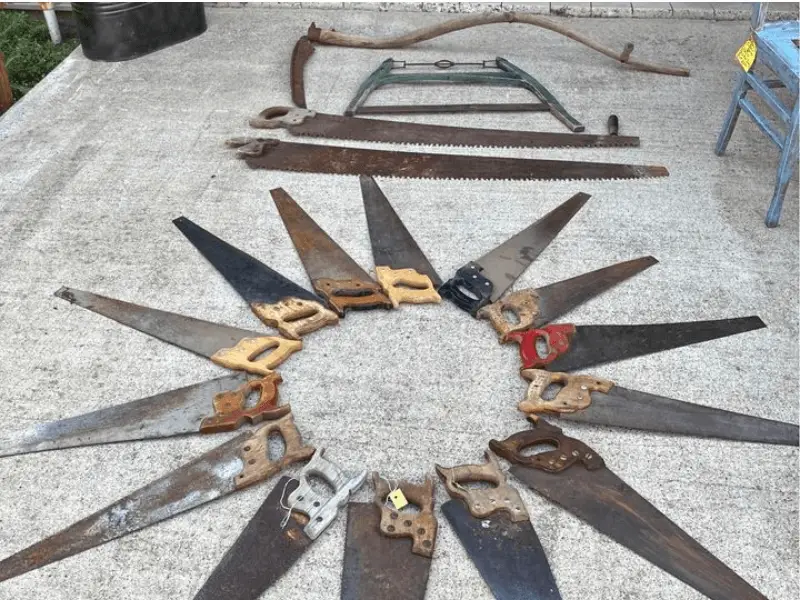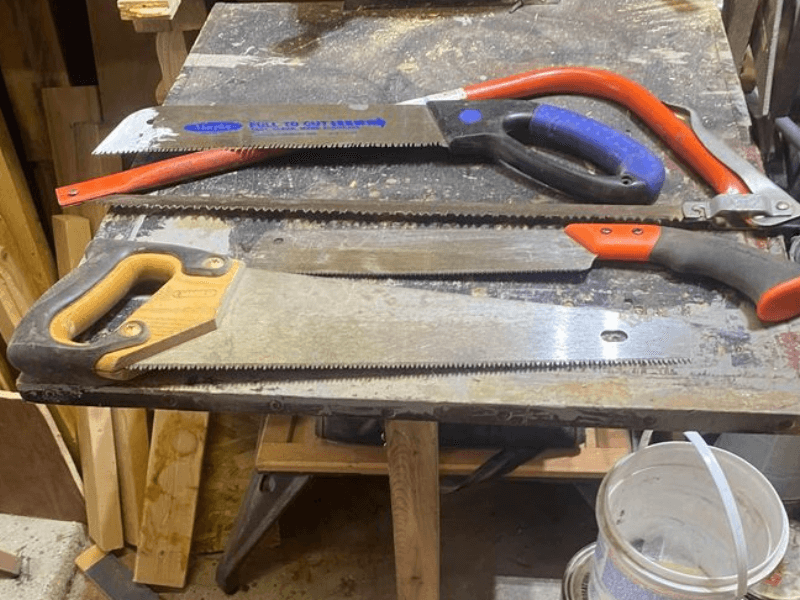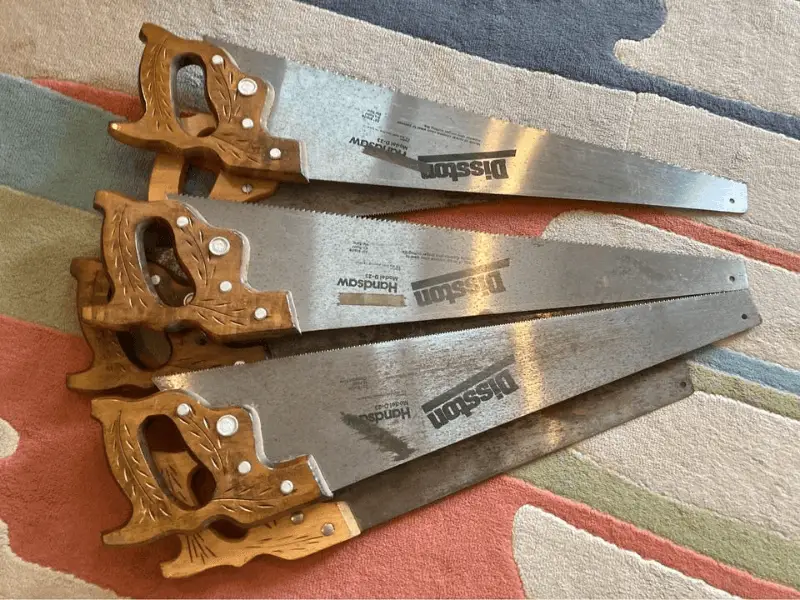Far from being quaint anachronisms or symbols of outdated and inefficient technology, handsaws are precision instruments that deserve a place in every contemporary shop. There are several reasons for such a claim, including safety, convenience, and economy, but of utmost importance for most woodworkers, whether professionals or hobbyists, is the fact that there are things you can do with handsaws that you can’t do any other way. Therefore, having handsaws in your tool kit gives you more choices and can produce better woodworking in the long run.
The History of Hand Saws

Now that we understand a thing or two about hand saws, we will take a trip down memory lane to where it all began for our trusty hand saws.
First and foremost, before we go any further, please understand that in the history of hand saws, the appreciation of scientific sawtooth design came relatively late. Before that, many early saws relied on a row of ragged teeth. That saw was so tricky to achieve a clean cut with. Mostly, it just wore away the wood. Nevertheless, if the user was lucky, some teeth had a form approaching the best shape for the saw to cut.
Therefore, most early artisans had to depend on axes and burn their way through the wood because they did not have saws capable of doing the job. However, saws were reasonably efficient during the Middle Ages because people began understanding sawtooth design. As a result, the value of cutting a notch (kerf) that would clear the thickness of the saw becomes known. Therefore, the modern tools we see today are refined developments from those days.
The Bronze Age ushered in the use of bronze for saws, and as we moved into the Iron Age, iron became the material of choice. The Romans, always ahead of the game, even had small, thin saws for intricate woodworking tasks. We’re talking early miter saw vibes here!
Note: The teeth of these early saws were ‘set’ or bent to one side, then the other, in a pattern known as ‘kerf,’ much like what we see in modern saws.
Fast forwarding to the 18th century, we see the emergence of two-person saws. These were large, heavy-duty saws and rip saws for cutting large timbers. It was a heavy 7-foot-long pitsaw where one man on top and the other below, under a steady rain of sawdust, would cut the log into a required size. However, the industrial revolution roared, and the need for hand saws momentarily declined. Machines were taking over.
Nevertheless, hand saws made a big comeback in the 20th century. They found their place in the modern woodworker’s toolbox with better materials and improved designs. And that’s where they still reside, ready to help us chisel, carve, and create.
So there you have it. The humble saw, a tool as old as time, has stood the test of time, proving its worth time and again in the skilled hands of the woodworker.
Picking your set of Hand Saws

For a start with the hand saws, you should at least start with the following set;
The Back Saw
The backsaw is an all-purpose saw for safe cuts on small workpieces where no one wants to push a small piece of wood (2′′ or less) through the table saw without all sorts of jigs and protection.
The back saw gets its name from the piece of folded, or cast, metal that runs along its back edge, supporting the blade. This heavy metal spine keeps the saw steady when cutting through wood. However, the metal spine limits the depth of your cut. Back saws have smaller teeth, resulting in a finer amount but a slower pace. There are two types of back saws: the tenon saw, and the dovetail saw.
Tenon saw
We usually use the tenon saw for cutting tenons
The dovetail saw
It is similar in appearance to a tenon saw, but it is smaller with more teeth, approximately 18 per inch (7 per centimeter), that produce the fine cuts helpful in cutting joints.
The dovetail saw is your secret weapon for perfect joinery that lasts a lifetime.
Rip saws and crosscut saws
Crosscut and rip saws are efficient alternatives to table and band saws when you want to keep your jigs, blades, or fences the same for a single cut. It is easier to take the saw to the wood than to take the wood to the saw.
Rip saw
The rip saw is a giant hand saw with a 26-inch blade. If you want to cut solid wood, the rip saw is your go-to.
Crosscut saw
The crosscut has a 24-inch blade. It is an ideal saw for cutting wood across the grain.
Coping saw
The coping saws are multipurpose for a safe, tricky cut where the bandsaw is unavailable. Therefore, a coping saw is your go-to if you have demanding tasks such as cutting curves or removing waste from joints, such as dovetails. It has a thin and narrow blade, which allows you to turn it quickly for those cuts.
The best hand saws for beginners
If you are looking for an ideal saw for those smaller jobs, and when cutting Tenon joints, this is the one you should get. It is A worthwhile addition to any toolbox as part of your work tools when working with wood. It has a good weight and feels well-balanced in the hand.
When choosing the best hand saw for your woodworking projects, there are several options to consider. One of the most popular is the Irwin Tenon Saw.
This hand saw features triple-ground tooth technology (TGT). The technology is to ensure that there is optimal cutting performance on both push and pull strokes. Therefore, if you’re looking for a saw that will not disturb you when starting your kerf, this is the best saw you will get.
Additionally, when looking for a saw, always ensure it has a comfortable handle if you want to make clean cuts. The Irwin tenon saw has a soft-grip handle, which reduces hand fatigue, especially if you’re in a long woodworking session.
If you’re looking for a saw that you can use with a miter box, this Tenon Saw is a fantastic choice.
DEWALT 15-Inch Standard Panel Saw
This hand saw is among the best with its distinctive tooth geometry and three-sided edge design. A low-friction ToughCoat blade coating and a rigid aluminum handle help the saw cut through the material smoothly and with less binding. The teeth are induction hardened to help them maintain their edge longer and resist damage from coming into contact with nails and staples embedded in wood.
If you’re looking for a multipurpose hand tool to rip and crosscut with, the DWHT20544L is the best.
This hand saw is a favorable option, especially for carpentry tasks like building, fine woodworking, repairs, and upkeep. It has Induction-hardened teeth that offset at the perfect angle to cut twice as fast as another saw. The teeth are also very sharp and maintain their edge for a long time, enabling you to cut through even the most rigid material without going dull. The handle is comfortable, and the mitered gauges molded into the handle are reasonably accurate.
I use it as my go-to saw to cut down fallen trees and limbs. Even with limbs 8–10 inches in diameter, Sawing 3-inch limbs takes 3–4 strokes. I have also used it to cut boards for decks, and it is excellent for that as well; it cuts fast and leaves a smooth cut even for cross cuts. Additionally, the blade of this saw has a harsh coating that offers low friction, and therefore, it has low resistance when dragging along the cut.
If you’re looking for a lighter saw that can be multipurposed in your shop, this is the best saw to get.
FAQ
What are the basic handsaws that I should buy?
The three basic handsaws that every woodworker should have in their toolkit are a crosscut saw, a rip saw, and a coping saw. You will use a crosscut saw to cut across the wood grain. On the other hand, you will use a rip saw to cut along the wood grain. A coping saw is a handheld saw with a thin, flexible blade that you will use for making intricate cuts and curves.
How often should I sharpen my hand saw?
It depends on how often you use your saw and how hard you use it. Generally, you should sharpen your saw every six months to a year if you use it regularly. However, if your saw is dull and not cutting as well as it should, it’s time to sharpen it.
What is the best length for a handsaw?
The best length of handsaw for you depends on the size of your projects and your personal preferences. Generally, saws between 18 and 26 inches are ideal for most woodworking projects. However, a smaller saw may be more comfortable and easier to use when working on smaller projects.
How do I choose a good hand saw?
When choosing a hand saw, there are several factors to consider, including the type of saw you need, the length of the blade, the number of teeth per inch, and the quality of the edge. Look for a saw with a comfortable handle and a blade made from high-quality steel. If you need clarification on what type of saw to buy, ask for recommendations from experienced woodworkers or salespeople.
What safety precautions should I take when using a handsaw?
When using a hand saw, it’s essential to wear safety goggles to protect your eyes from flying debris. Additionally, secure the material you’re cutting in a vice or clamp to prevent it from moving and causing accidents. Always use the saw properly, applying even pressure and following the correct cutting motion to minimize the risk of injury.
Conclusions
When thinking about hand planes in general, whether you want to buy them or just for the available information, pay attention to the following details:
- The cut you need to make
- The length of the blade
- The number of teeth per inch
- The quality of the edge
Comfort is also essential, as a comfortable grip can reduce hand fatigue during long woodworking sessions.
Finally, understand maintenance and sharpening, as they are crucial to keeping your hand saws in optimal condition. Sharpening your saw regularly and following proper maintenance techniques will ensure that your saws perform at their best.



